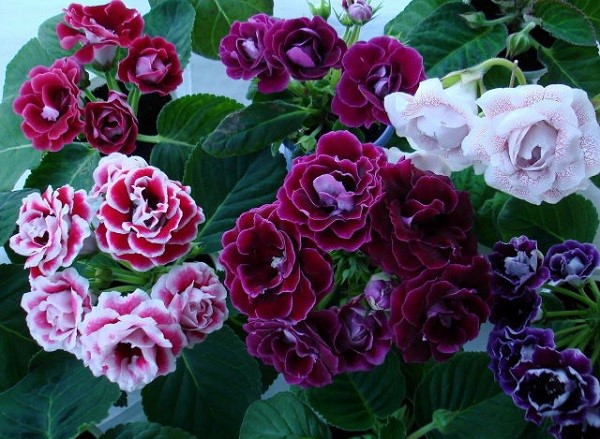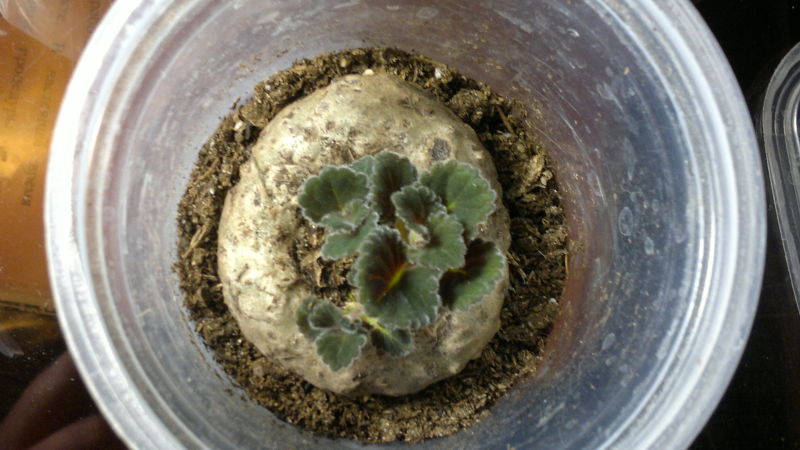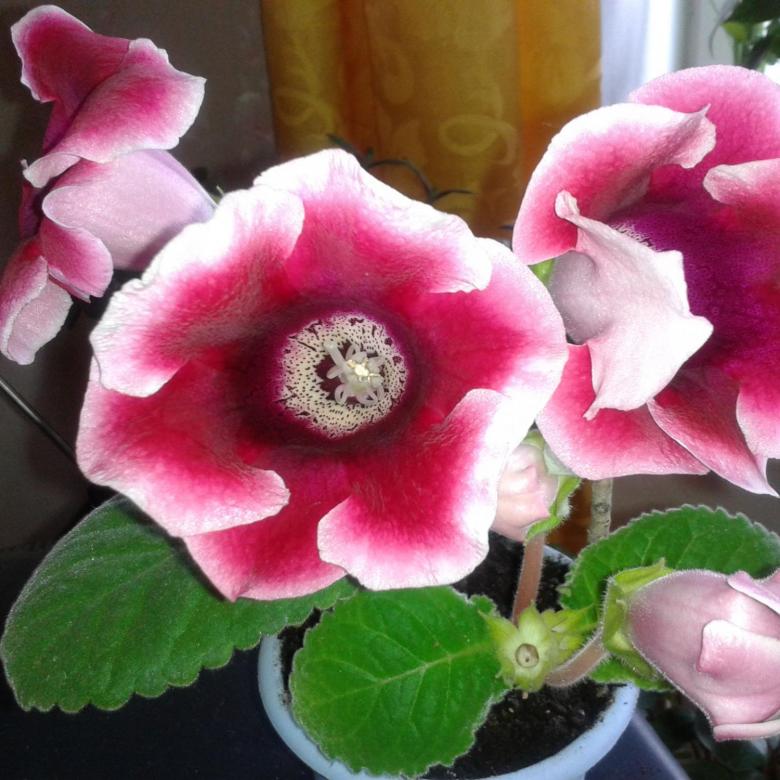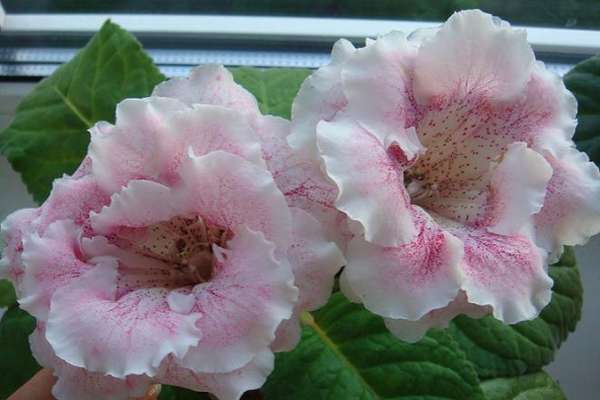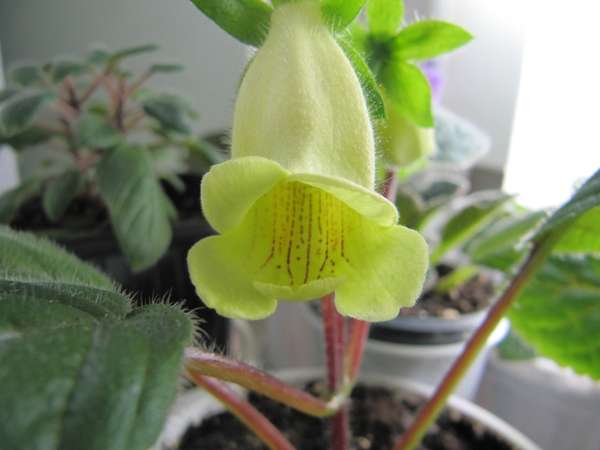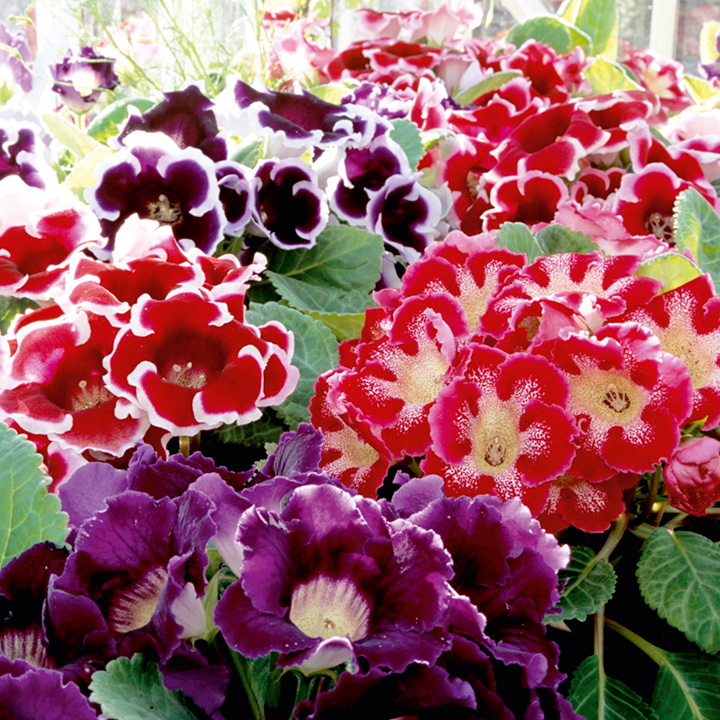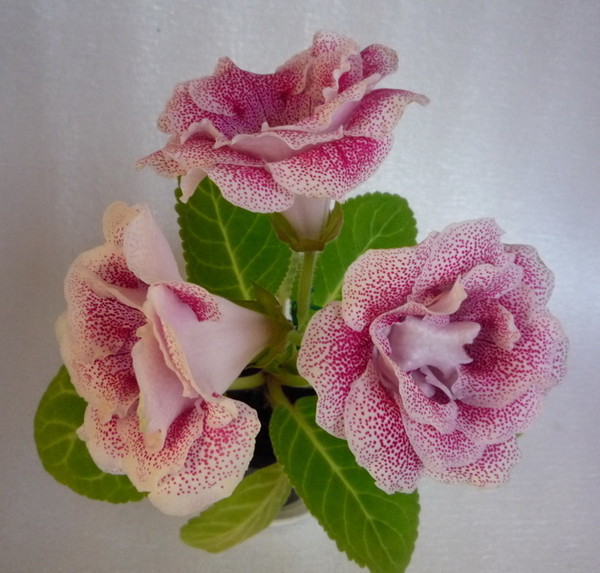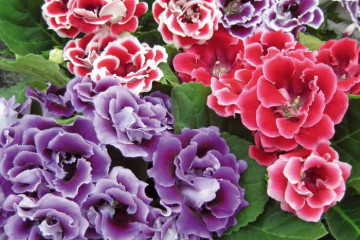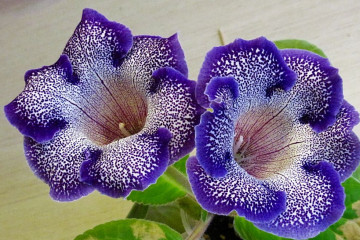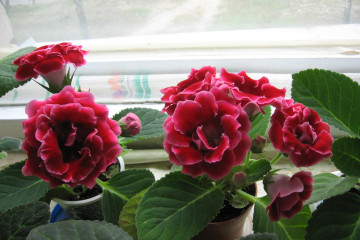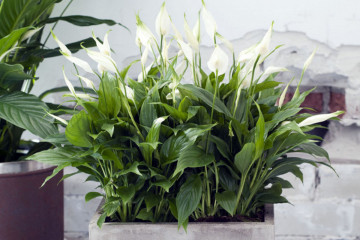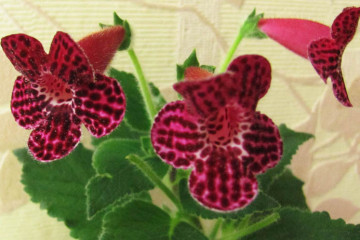What does terry gloxinia look like - types of flower
Content:
An indoor plant with a cap of unusually elegant flowers is terry gloxinia. For more than two centuries this Latin American has been decorating the interiors of Europeans. There are many varieties of plants, each of them is not inferior to the other in beauty.
About the origin of the species
In the wild, this plant of the Gesneriev family has existed for a long time, hiding in the rocky crevices of Brazil and other countries of the southern continent. At the end of the 18th century, a scientist from Germany Benjamin Peter Gloxin came across a small plant with bright, beautiful flowers in a speck. He introduced a new species to Europe, giving the flower its name.
Gloxinia settled on the windowsills of houses, they began to grow it in greenhouses. To create varieties, only 2 species were suitable for breeders: royal gloxinia and beautiful. But they were also able to give a gorgeous floral variety that pleases the eye.
A few decades after the Latin American plant came to Europe, another scientist, Wilhelm Zinning, discovered a flower unfamiliar to him in his greenhouse. Having engaged in its cultivation, the botanist gave the plant the name "sinningia", not suspecting that the culture had already been named gloxinia.
Description of the species
In South America, this plant is found everywhere: on the rocks of Mexico, in the forests of Peru, along the slopes of the Andes. A visitor from the tropics also feels comfortable on the windowsills of Eurasia. The plant is unassuming to care for and is easy to propagate.
The variety of species is distinguished by the color of the inflorescences, their shape (bells or shoes), the number and arrangement of petals, and the size of the leaves.
If we consider the species of gloxinia as a whole, we can distinguish common characteristics characteristic of all plants.
Features of gloxinia
| Sign | Description |
| Bush | Low - usually a little more than 10 cm (although in the wild it can reach 1.5 m). |
| Root | In true gloxinia, it looks like a carrot. Even in domestic plants, it is able to reach 0.4 m. In synningia, it is a fleshy tuber. |
| Leaves | Thick, green, sitting on a powerful handle. They can be shaggy and smooth, oval and oblong, with hairs or velvet-like down. In some varieties, the diameter is small - up to 1 cm, in others it reaches 0.2 m. They grow in groups of 3-4 pcs. or oppositely located. Forms a ground-level low outlet. |
| Flowers | The most common form is an elongated gramophone * on a peduncle with a length of 1 to 15 cm. There are 5 stamens inside, each with 4 anthers. A straight ring-shaped pistil rises between them (it may be absent in hybrids). |
| Fetus | Small cone-shaped box (up to 1 cm). Inside contains seed - brown ellipsoids 1 mm long. |
* Some believe that the name gloxinia comes from the shape of the inflorescence. After all, the word "bell" in German sounds like glocke.
Bushes come in a variety of sizes. It depends on the diameter of the foliage rosettes:
- less than 20 cm - miniature;
- 20-30 cm - semi-miniature;
- over 30 cm - standard.
All varieties of gloxinia are light-loving plants, but they can get burns from direct sunlight.
Common varieties
Knowing what gloxinia looks like, it is easier to choose a houseplant to decorate your home interior. Here you can sometimes get confused - such a variety of subspecies and varieties in terry specimens.
Gloxinia subspecies
| Name | Features of the |
| Gloxinia perennis | It translates as "year-round", because it has a small period of rest. You can recognize the variety by the leaf plates - they are reddish below. Fleshy shoots are speckled. Axillary flowers are collected on one peduncle. The bush reaches a height of 0.5-0.7 m. |
| Royal | Gloxinia is truly worthy of queens because of its beauty. It stands out for the velvety texture of dark green oval leaves, arranged in 4-6 pairs on a thick stem up to 10 cm high. Slightly drooping large bells with a diameter of 7 cm are painted in a dark purple hue. They are crowned with a long peduncle (about 20 cm). |
| Lovely gloxinia | At first glance, it looks like a royal, but different: · A variety of color shades (purple, pink, blue, white, violet); · The shape of the flowers; · Lighter color of the plate. Leaves are broadly oval, with a dense short downy, located on long cuttings. If you look closely, you can see the original embossed pattern of veins. |
| Tiny | It stands out with small legs, each containing 1 flower. At the corollas, the curtain is short, two-colored - purple on top, white below. It fully justifies its name - the bush barely reaches 2.5 cm.Small and velvety oval-shaped leaves on the plant up to 1 cm long. |
On the basis of subspecies, breeders create new beautiful varieties. The most popular among them:
- Yesenia is a delicate "rose" with a rich beet color;
- Winter cherry - her burgundy petals are speckled with white specks;
- Southern night - with small inflorescences of a black and burgundy hue;
- Tigrina mix - the variety got its name because of the unusual pattern on lilac, raspberry, lilac or white petals;
- Tiger Empress - large wine-red bells have wavy edges;
- Blue Gloxinia Avanti - petals, painted in all shades of blue, have a white border along the edge;
- Blue and white - it is distinguished by an original combination of colors: the white edging from the edge smoothly turns into a blue tint, which, in turn, turns into purple;
- Cleopatra is a wonderful representative of chintz coloring. White bells seem to be dusted with lilac and pinkish peas;
- Blanche de Meroux is characterized by a large velvety rosette, from which crimson open gramophones with a white core peep out;
- Blond Giselle is grace itself. On the pubescent stem, large bells bloom, dotted with purple or pinkish specks, there is a lilac tint in the necks;
- Madame Margaret - the crimson petals have wavy edges framed by a white narrow border;
- Kaiser Friedrich is characterized by a bright crimson color of the petals, framed by a wavy white border; the creamy neck is strewn with small specks;
- Gloxinia white - can be recognized by large snow-white petals with a greenish-purple throat;
- gloxinia Courage has large white gramophones diluted with pink specks;
- Merlin - it is difficult to see the true white shade of the petals behind the rich dark lilac speck;
- Lady Jane - dense small peas are scattered over the white flowers;
- Prins Albert - in the variety, a smooth transition from a blue-violet hue to a deep black visually turns the petals into a royal mantle;
- pink gloxinia The tale in the middle is colored with a crimson color, the lighter throat is strewn with dark specks;
- under the name Fusion Gloxinia, they mean hybrid varieties that stand out in a variety of shapes and colors.
The decisive color is for gloxinia.It is the bright shades that primarily attract lovers of unusual indoor plants. Based on this feature, it is possible to draw up a classification based on the hue.
Gloxinia varieties by color
| Shades | Names of varieties |
| Gloxinia terry white | Madonna, Article De Luxe, The Snow Queen, Fairy Wreath, High Light, Minx, Stephanie, Frosty Haze |
| Red gloxinia | Brocada, Estasi, Bohemia, Parisienne, Catarinka, Scarlett, Rua de Rouge, Etoile de Few, Queen of May |
| Gloxinia violet | Shagane, Starry night, Eliza, Shahinya, Madame Butterfly, Neptune, Light Violet Avant |
| Burgundy gloxinia | Kaiser Wilhelm (with a wide white border), Dream of Love, Hope, Parure |
| Black gloxinia | Prince, Panther, Black Hollywood, Full Moon, Black Girl, Mr. Violet, Tamerlane, Viola |
| Pink | Orlans, Masquerade, Pinik Flamingo, Rokoko Pink, Peach Rose, Dolce Vita, Triumph Tender |
There are also blues, blues, lilacs and other cool colors. There are monochromatic flowers and diluted with various colors. As for the yellow gloxinia, flower growers still know one variety of minisinningia - Conspicua, created artificially.
When and how gloxinia blooms
To grow a tropical flower in the Russian climate with comfort, you need to know some of the features of the plant. Depending on the varieties, gloxinia is distinguished by external signs. The culture also has a common biological development.
Flowering periods
Gloxinia throws out the first buds in March and can delight with beautiful flowers until late autumn. There are varieties in which the first color lasts 3 months. Then, after a short break, new buds appear.
From the end of September, the bushes are fading and getting ready for winter rest. This point should be taken into account when caring for gloxinia. Watering is gradually being reduced to nothing. The flowerpot is taken out to a cool room, where it is maintained at +10 degrees.
The appearance of flowers
The table above provides a brief description of the buds. To this we can add that flowers, depending on the variety, are classified according to the following characteristics:
- bell-shaped - tubular, cubic, funnel-shaped;
- in the direction of growth - looking up or down;
- by the number of petals (at least 5) - terry, semi-double and simple (with the 1st row);
- along the rim - with straight or bent petals;
- fringed, crimped or not.
Gloxinia flower has a rich palette. They are monochromatic, 2-color and multi-color. Tigrin is characterized by a contrasting monochromatic border along the edge of the petal. It can differ in the strength of the shade from the main color or be in contrast to it. Flowers strewn with specks are called chintz.
On one bush, from 8 to 30 buds are formed at the same time. Their diameter ranges from 8-12 cm. The number of gramophones depends on the number of rosettes emitting 1 soft peduncle, which can be short (2 cm) or long (25 cm).
Gloxinia is not just a beautiful decorative flower. He is credited with positive energy, which has a calming effect on the nervous system and lifts the mood. The plant absorbs harmful impurities from the air, contributing to the purification of the atmosphere. Placing gloxinia in a nursery will give your baby a restful sleep.
Video
